8 Ways to Decorate with Lavender, This Year’s Hottest New Color Trend
Take inspiration from these designer-approved tips to bring a lavender haze into your own space.
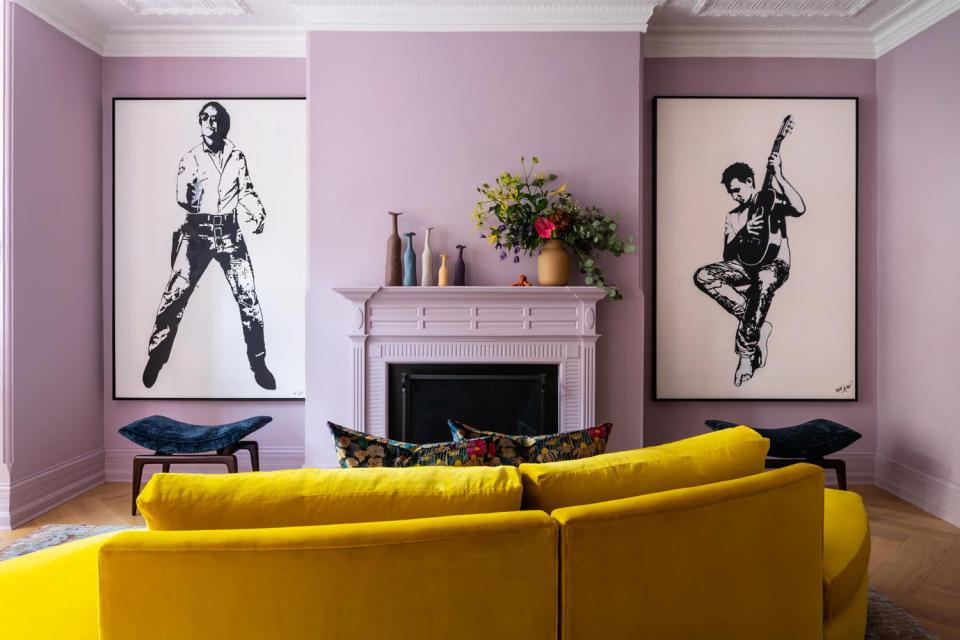
Courtesy of Sawyers Design / Ansel Olson
Lavender is dominating the color charts as the latest must-have shade of 2023. First, the soft shade of purple took the fashion runway by storm, drenching apparel with the spring color. Then, the floral hue trickled into home decor as pastels came back in style. By the time Taylor Swift released her hit song "Lavender Haze," it had officially become one of the most popular colors of the year. We caught up with designers and color experts to find out what sparked the lavender obsession and get their best tips for incorporating the shade into a contemporary space.
Why Lavender Is So Popular Now
“The world is a harsh place for many people at the moment. There are challenges at every level of life, from balancing the day-to-day to huge political issues,” says designer Kevin Sawyers, principal of Sawyers Design. “We need a light and airy color to lift our spirits and calm our nerves, and lavender is a pure, innocent, clean, and often spiritual color.”
Sawyers also credits part of the hue’s fame to tech giant Apple, who introduced purple iPhones in 2021, rebuilding the color’s reputation.
"Over the past two years, we have seen an increase in interest in lavender,” says Andrea Magno, director of color marketing and development at Benjamin Moore, which featured the color in its annual Color Trends palettes with Hint of Violet 2114-60 in 2022 and New Age 1444 in 2023. “Lavender offers something new and fresh, which is something we see people looking for to make their spaces feel personalized and unique.”
Related:10 of the Prettiest Purple Paint Colors to Upgrade Any Room
How to Choose the Right Shade of Lavender for Your Space
Lavender is an intriguing and versatile shade because it can lean warm or cool depending on the undertone. “While lavender falls on the cool side of the color wheel, when there is enough red in the color, the result will be a warm feel. If there is more blue in the lavender shade, it will take on a much cooler cast,” Magno explains.
The best lavender shade for the space ultimately depends on the room’s cardinal direction, natural light, and how you want it to feel. Sampling a range of lavender options on each wall is the best way to decide what feels best in the space. “I often choose the color I think I want and select two other colors that are very close,” Sawyers says. For example, you might choose another lavender shade that has a stronger red undertone and another that has a more dominant blue undertone, getting brush-outs of each. “A small swatch subjected to sunlight or age can be very misleading, so do the extra bit of legwork for a good result.” Ultimately, it’s about choosing colors that fit your personal taste and design style best.
Related:Every 2023 Color of the Year We Know So Far
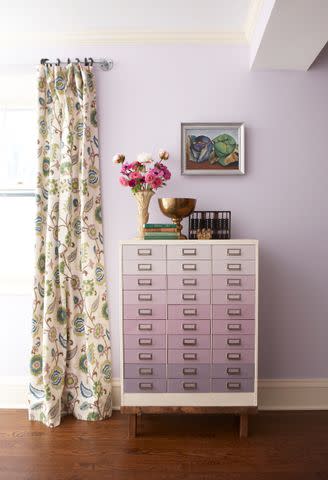
Michael Partenio
How to Decorate with Lavender
You probably know that the color lavender is associated with the aromatic plant from which it gets it’s name. But what you might not know is that the flower typically symbolizes healing, tranquility, cleanliness, and purity. The color encourages relaxation and restoration, which is why it is typically used in bedrooms and bathrooms. However, contemporary designers have spread the color beyond the confines of those spaces and into more communal areas.
"Whether the preferred style of a room is traditional, modern, or somewhere in between, lavender hues make a unique addition to any space that is understated, vaporous, and sophisticated," Magno says. She explains that the shade promotes a state of calm in everyday life.
Read on to discover how interior designers have celebrated the lavender renaissance and take inspiration for your own space.
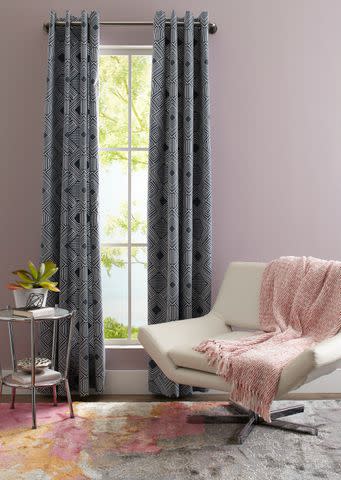
Jacob Fox
1. Use Lavender as a Neutral
"Soft and slightly muted lavenders offer a great opportunity to take part in this trend, but in a way that will stand the test of time," Magno says. Paler shades of lavender add a subtle touch of color to a room while keeping it versatile, making lavender "an unexpected, or unconventional neutral." Lavender shades with a gray undertone tend to be the most versatile, allowing you to introduce the purple shade into your home and play around with a range of other color accents, like navy, charcoal, and white. "The result is a room that feels fresh and contemporary, and will not date quickly," Magno says.
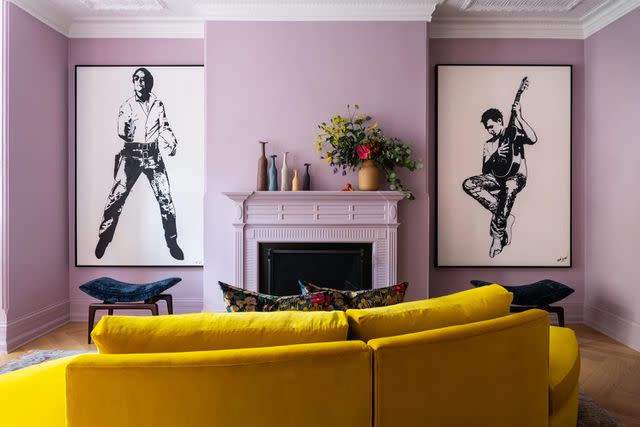
Courtesy of Sawyers Design / Ansel Olson
2. Pair with a Complementary Shade
As a shade of purple, lavender’s complementary color is yellow. So, accent a lavender room with yellow, and you’ll get a high contrast that creates a bold impact, just like this living room designed by Sawyer. The unapologetic mustard sofa creates a striking accent, and the modern furnishings immediately make the space feel cool and contemporary.
3. Avoid Fussy Pattern
Take lavender out of the past and into the present with large areas of the color. "For a contemporary interior, lavender is best introduced in subtle tones and large plains of color for drama," says Anne Hindley, director and principal architect at Hindley & Co. Fussy patterns—like florals and chintz—are better avoided to prevent the scheme from feeling outdated. Instead, look to techniques like color blocking to introduce big plains of solid color and achieve a fresh, contemporary look.
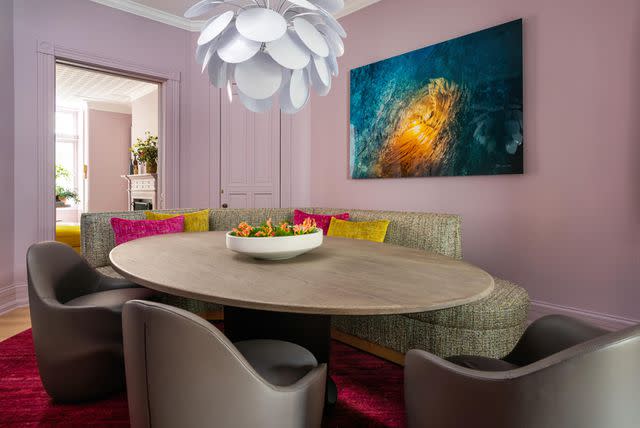
Courtesy of Sawyers Design / Ansel Olson
4. Drench a Room in Color
Paint the whole room lavender, walls, doors, architraves, fireplaces, and all; the effect is brilliantly bold and ultra-contemporary, as evidenced by Sawyers’ Dupont Circle project. "I needed to make the new palette appropriate for a traditional setting and DC while staying true to the client’s more modern style," says Sawyers. Drawing color inspiration from the Federal period and Victorian era, he modernized the lavender shade by painting the walls, doors, trim, baseboards, and fireplace surrounds the same color. "The only element to remain the more traditional white was the crown," he says. This technique is ideal for small spaces as color-drenching in a pale color, like lavender, will make them seem bigger.
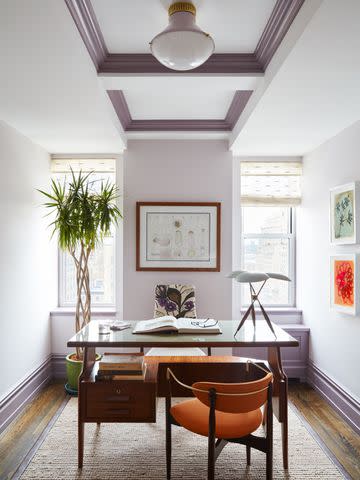
Courtesy of Mendelson Group / Tim Lenz
5. Go Monochrome
Stay in a constant lavender haze with a monochrome color scheme. "In this Manhattan duplex study, we painted the walls a light lavender and the trim a darker purple to add contrast to this relaxing work-from-home spot," says interior designer Gideon Mendelson, founder and director of Mendelson Group. Layering the same color in different tonal variations creates a mesmerizing, dramatic, and fully immersive scheme. To successfully carry out a monochrome palette, follow the 60-30-10 rule to help you find the perfect tonal balance.
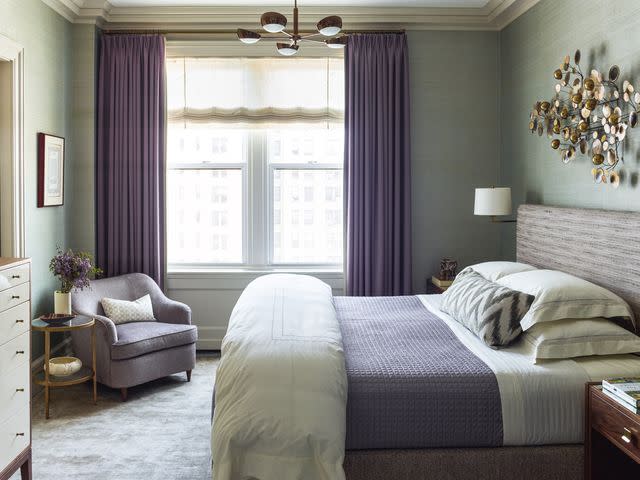
Courtesy of Mendelson Group / Eric Piasecki
6. Pair Lavender with Green
As if plucked straight out of Provence, lavender and green create a soothing and picturesque color scheme made for a bedroom. "In this west-end bedroom, we paired lavender with sage green to create a sophisticated and calm primary bedroom," Mendelson says. The sage textured wallpaper provides a gentle backdrop for soft lavender textiles introduced through the curtains, club chair, and bed coverlet. The result is a deeply therapeutic and relaxing environment that's perfect for a primary bedroom.
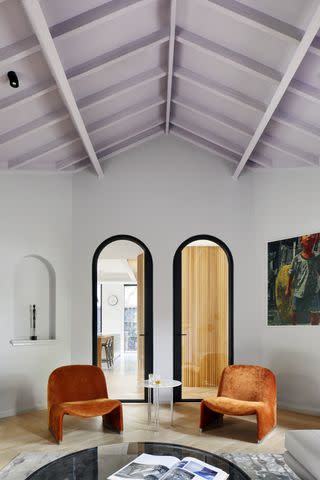
Courtesy of Hindley & Co / Tatjana Plitt
7. Consider the Fifth Wall
While we’re pretty sure Taylor Swift wasn’t writing about home decor when she penned Lavender Haze, the line “staring at the ceiling with you” is right on trend. Add an unexpected splash of color to your home with a lavender ceiling. Ceilings that are painted a lighter color than the walls feel higher, while darker colors make the ceiling feel lower—a rule Hindley took into account when designing this living room. “This room had a shadowy feel that we wanted to amplify by using different shades of lavender on different surfaces to create a moody depth both during the day and at night,” she says. “The stained brown exposed timbers felt heavy and outdated, so we wanted to paint them out but felt that the detail deserved more than white paint.” Instead, they painted the beams and ceiling lavender to make a fun feature out of them.
8. Pair with Deep Reds
Because lavender is a surprisingly versatile color, it lends itself to a varied palette. "For a slightly off-beat look, pair lavender with a classic, deep red such as Dinner Party AF-300 and the ever-so-slightly off-white Steam AF-15," suggests Magno. The rich red adds depth and an element of sophistication and maturity that grounds the light, optimistic, and whimsical nature of lavender.
For more Better Homes & Gardens news, make sure to sign up for our newsletter!
Read the original article on Better Homes & Gardens.

